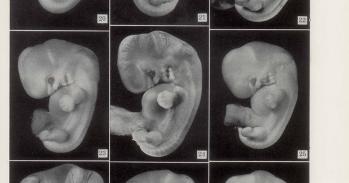
Studies in La Paz, the highest city in the world, are helping to uncover a link between prenatal conditions and heart disease in later life.
Studies in La Paz, the highest city in the world, are helping to uncover a link between prenatal conditions and heart disease in later life.
High-altitude babies showed a pronounced reduction in birth weight compared with low-altitude babies, even in cases of high maternal nutritional status.
Heart disease is the greatest killer in the UK today, accounting for four in every 10 deaths and imposing a substantial burden on the nation’s health and wealth. The concept is familiar to us all that traditional risk factors, such as smoking and obesity, and genetic makeup increase the risk of heart disease. However, it is now becoming apparent that a third factor is at play – a developmental programming that is predetermined before birth, not only by our genes but also by their interaction with the quality of our prenatal environment.
A biological trade-off
Pregnancies that are complicated by adverse conditions in the womb, such as happens during pre-eclampsia or placental insufficiency, enforce physiological adaptations in the unborn child and placenta. While these adaptations are necessary to maintain viable pregnancy and sustain life before birth, the adaptations come at a cost, claiming reduced growth as a biological trade-off. In fact it’s more than just growth that is affected – we now know that the trade-off extends to the development of key organs and systems such as the heart and circulation, which increases the risk of cardiovascular disease in adult life. Overwhelming evidence in more than a dozen countries has linked development under sub-optimal intrauterine conditions leading to low birth weight with increased rates in adulthood of coronary heart disease and its major risk factors – hypertension, atherosclerosis and diabetes.
The idea that a fetus’ susceptibility to disease in later life could be programmed by the conditions in the womb has been taken up vigorously by the international research community, with considerable efforts focusing on nutrient supply across the placenta as a risk factor. But nutrient supply is just part of the story. How much oxygen is available to the fetus is also a determinant of growth and the risk of adult disease. Dr Dino Giussani’s research group in the Department of Physiology, Development and Neuroscience is asking what effect reduced oxygen has on fetal development by studying populations at high altitude.
Lessons from high altitude
Bolivia lies at the heart of South America, split by the Andean Cordillera into areas of very high altitude to the west and areas at sea-level to the east, as the country extends into the Amazon Basin. At 400 m and almost 4000 m above sea-level, respectively, the Bolivian cities of Santa Cruz and La Paz are striking examples of this difference.
Pregnancies at high altitude are subjected to a lower partial pressure of oxygen in the atmosphere compared with those at sea-level. Women living at high altitude in La Paz are more likely to give birth to underweight babies than women living in Santa Cruz. But is this a result of reduced oxygen in the womb or poorer nutritional status?
The research team studied birth weight records from healthy term pregnancies in La Paz and Santa Cruz, especially from obstetric hospitals and clinics selectively attended by women from either high- or low-income backgrounds. High-altitude babies showed a pronounced reduction in birth weight compared with low-altitude babies, even in cases of high maternal nutritional status. Babies born to low-income mothers at sea-level also showed a reduction in birth weight, but the effect of under-nutrition was not as pronounced as the effect of high altitude on birth weight; clearly, fetal oxygenation was a more important determinant of fetal growth within these communities
Remarkably, although one might assume that babies born to low-income mothers at high altitude would show the greatest reduction in birth weight, these babies were actually heavier than babies born to high-income mothers at high altitude. It turns out that the difference lies in ancestry. The lower socio-economic groups of La Paz are almost entirely made up of Aymara Indians, an ancient ethnic group with a history in the Bolivian highlands spanning two millennia. On the other hand, individuals of higher socio-economic status in Bolivia represent a largely European and North American admixture, relative newcomers to high altitude. It seems therefore that an ancestry linked to prolonged high-altitude residence confers protection against reduced atmospheric oxygen.
Do these early influences of oxygenation feed through to increased risk of cardiovascular disease? A large-scale, five-year study to determine this has been initiated in the two cities that will link birth weight data with measurements of cardiovascular health and disease in Bolivian high- and lowlanders. But an early indication has been supplied by a somewhat unlikely source: Bolivian hen eggs.
Mountain chicks
Dr Giussani’s group has discovered that they can replicate the results found in Andean pregnancies in eggs: fertilised eggs from Bolivian hens native to sea-level show growth restriction when incubated at high altitude, whereas eggs from hens that are native to high altitude show a smaller growth restriction. Using hen eggs has allowed the researchers to accomplish something that would take generations of migration in human populations to demonstrate: moving fertilised eggs from hens native to high altitude down to sea-level. This not only restored growth, but the embryos were actually larger than sea-level embryos incubated at sea-level. And, importantly, when looking for early markers of cardiovascular disease, it was discovered that growth restriction at high altitude was indeed linked with cardiovascular defects – shown by an increase in the thickness of the walls of the chick heart and aorta.
Bringing the Andes to Cambridge
To have hopes of clinical intervention, we need to understand why reduced oxygen should be a trigger for a prenatal origin of heart disease. Towards this goal, the group’s most recent data studying rat pregnancy complicated with reduced fetal oxygenation have indicated that the adverse effects on cardiovascular development may be secondary to a disturbance known as oxidative stress. The body normally produces by-products of oxygen called free radicals and, unless these are neutralised by antioxidants, they cause damage to cells. If oxidative stress is the underlying cause of cardiovascular defects, this offers the highly interesting possibility of using antioxidants to treat pregnancies complicated by reduced oxygen delivery to the fetus, be it at sea-level or high altitude. This may halt the development of heart disease at its very origin, bringing preventive medicine back into the womb.
For more information, please contact the author Dr Dino Giussani (dag26@cam.ac.uk) at the Department of Physiology, Development and Neuroscience. Research described here was sponsored by the British Heart Foundation, Biotechnology and Biological Sciences Research Council (BBSRC), Lister Institute of Preventive Medicine, Royal Society and Wellcome Trust. Dr Giussani is a member of the Centre for Trophoblast Research.
This work is licensed under a Creative Commons Licence. If you use this content on your site please link back to this page.





